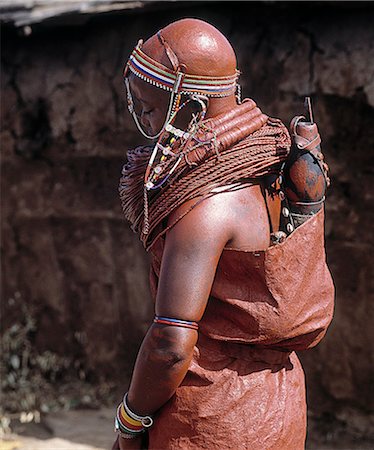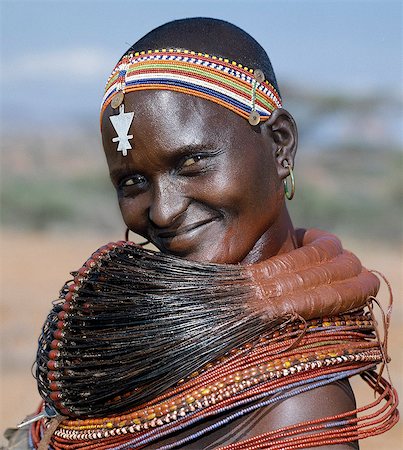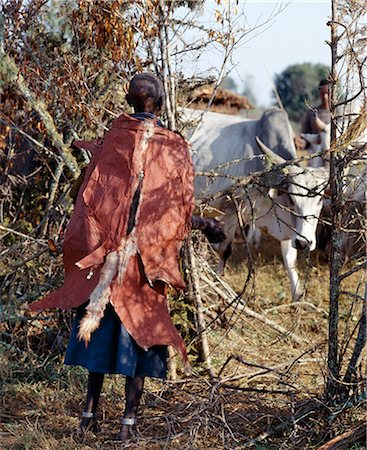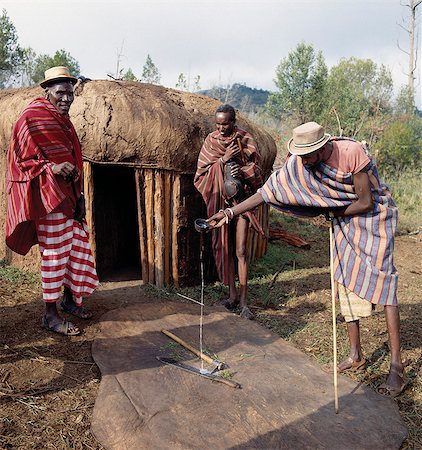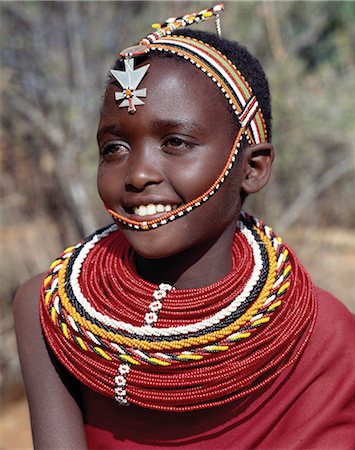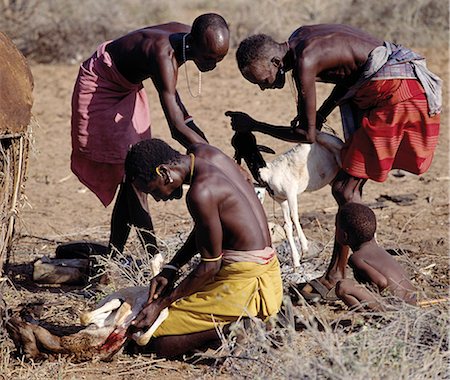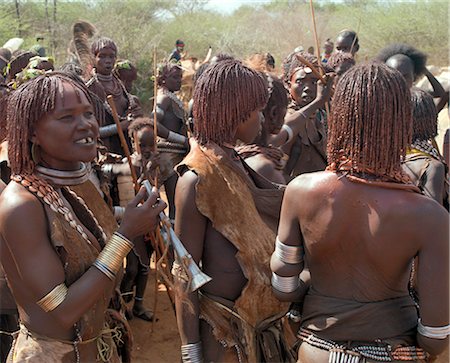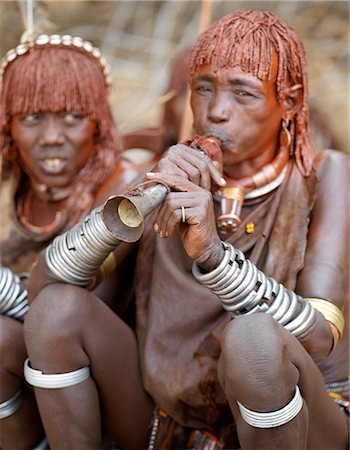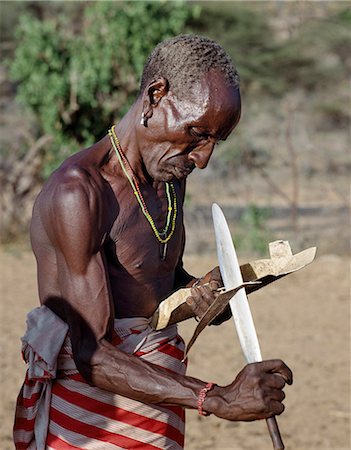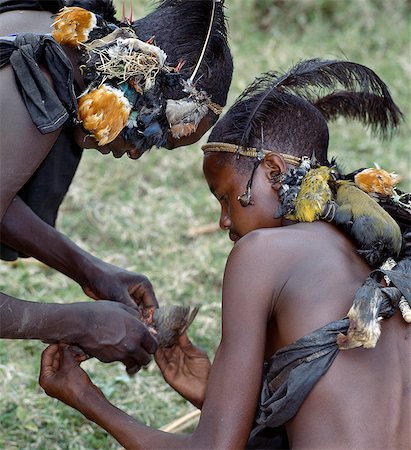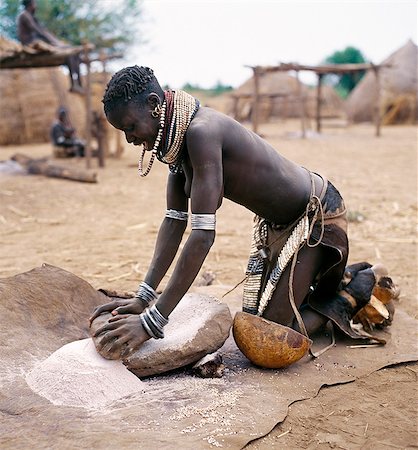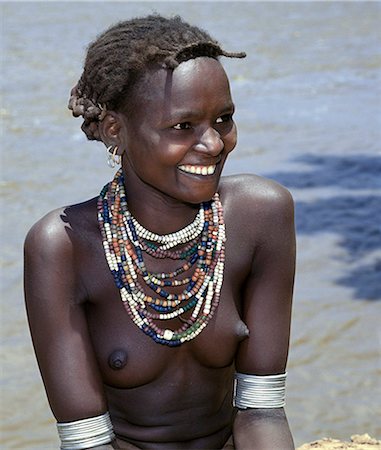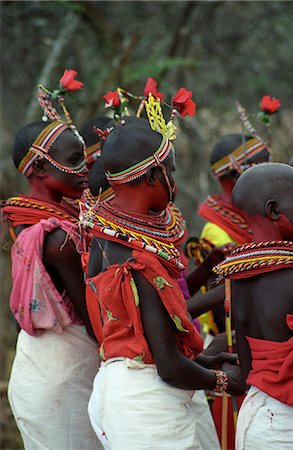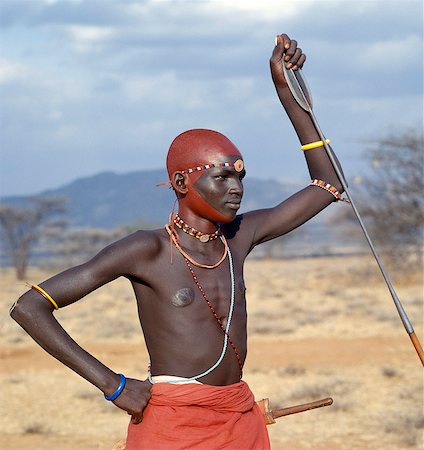-
A Samburu bride waits pensively outside her new home until she is enticed in with promises of cattle.Her wedding gown is made of three goatskins, which are well oiled and covered in red ochre.She carries on her back a gourd full of milk and a small wooden jar containing butter.She now wears the mporro necklace of married women.
Rights-Managed
-
The evening before a Samburu boy is circumcised,he must lean over his mother under a special ochred goatskin cape as she milks a cow that has not given birth more than twice. This milk will be kept overnight in a traditional wooden gourd-like container and will be poured over the boy's head just before he is circumcised early the next morning.
Rights-Managed
-
During Samburu wedding celebrations,warriors resplendent with long Ochred braids dance with young girls who have put on all their finery for the occasion. Both warriors and girls smear their faces,necks and shoulders with red ochre mixed with animal fat to enhance their appearance. Two spears are tipped with ostrich-feather pompoms.
Rights-Managed
-
A Samburu woman wearing a mporro necklace, which denotes her married status. These necklaces were once made of hair from giraffe tails but nowadays, the fibres of doum palm fronds, Hyphaene coriacea, are used instead.The red beads after which the necklace is named are wound glass beads made in Venice c.1850.
Rights-Managed
-
A Samburu woman wearing a mporro necklace, which denotes her married status. These necklaces were once made of hair from giraffe tails but nowadays, the fibres of doum palm fronds, Hyphaene coriacea, are used instead.The red beads after which the necklace is named are wound glass beads made in Venice c.1850.
Rights-Managed
-
A Samburu woman wearing a mporro necklace, which denotes her married status. These necklaces were once made of hair from giraffe tails but nowadays, the fibres of doum palm fronds, Hyphaene coriacea, are used instead.The red beads after which the necklace is named are wound glass beads made in Venice c.1850.
Rights-Managed
-
The invited guests at a Samburu wedding gather together to sing in praise of the couple and to dance. Celebrations will go on late into the night.
Rights-Managed
-
Samburu girls are given strings of beads by their fathers when they are still young. As soon as they are old enough to have lovers from the warrior age set, they regularly receive gifts from them.Over a period of years, their necklaces can smother them up to their necks.
Rights-Managed
-
A Samburu mother shaves her sons head outside her home the day before he is circumcised.Round her neck hangs his nchipi, the distinctive decoration of every boy who participates in the circumcision ritual. The strings of blue beads terminate in large bronze coloured wings of a torpedo shaped beetle, Sterocera hildebrandti.
Rights-Managed
-
A Samburu woman wearing a mporro necklace,which signifies her married status.These necklaces,once made of hair from giraffe tails,are now made from fibres of doum palm fronds (Hyphaene coriacea). The beads are mid-19th century Venetian glass beads,which were introduced to Samburuland by early hunters and traders.
Rights-Managed
-
A Samburu mother wears an ochred goatskin cape ready for milking a cow the evening before her son is circumcised. This distinctive cape is worn only at circumcision ceremonies. The milk must be drawn from a cow that has not given birth more than twice and will be poured over her son's head just before he is circumcised early the next morning.
Rights-Managed
-
Young Samburu girls dance during a wedding celebration. By arching their backs and thrusting out their chests,they flick their beaded necklaces up and down while dancing silently to the songs of the warriors. Their bodies and necklaces have been smeared with red ochre.
Rights-Managed
-
A young Samburu girl dances during a wedding celebration. By arching her back and thrusting out her chest,she flicks her beaded necklaces up and down while dancing silently to the songs of the warriors. Her body and necklace have been smeared with red ochre,and her eyebrows blackened with charcoal dust mixed with animal fat.
Rights-Managed
-
A Samburu woman singing. The strings of black and white beads hanging from her ears signify that she has two grown-up sons who are warriors of the tribe. Note: the traditional horn snuff container hanging from her neck.
Rights-Managed
-
The day before Samburu boys are circumcised in their lorora,(a purpose-built circumcision encampment),senior elders will bless the sharp instruments of every household,such as pangas and axes,by pouring a little milk over them as they intone a blessing. The instruments must be laid out on the oxhide upon which the boy of each household will be circumcised.
Rights-Managed
-
Gabbra women sing and dance to celebrate a wedding. The traditional metal ornamentation on their heads is called malmal.
Rights-Managed
-
Samburu girls are given strings of beads by their fathers when they are still young. As soon as they are old enough to have lovers from the warrior age-set,they regularly receive gifts from them. Over a period of years,their necklaces can smother them up to their necks. The metal cross-like ornament hanging from the girl's headband has no religious significance.
Rights-Managed
-
Samburu girls are given strings of beads by their fathers when they are still young. As soon as they are old enough to have lovers from the warrior age-set,they regularly receive gifts from them. Over a period of years,their necklaces can smother them up to their necks. The metal cross-like ornament hanging from the girl's headband has no religious significance.
Rights-Managed
-
A Samburu boy the day before his circumcision.He has daubed the right side of his face and body with white clay while drawing water from a source that never dries up. Each boy will carry for this purpose a new gourd shaped container made by his mother from hollowed out wood.
Rights-Managed
-
Mothers rub animal fat into their sons cloaks to make them supple. This task is performed shortly before the boys set out on an arduous journey to collect sticks, staves and gum to make bows, blunt arrows and clubs after their circumcision.
Rights-Managed
-
Kenya, Samburu District, South Horr, Samburu District, Kenya. The ritual helpers of two Samburu boys slaughter and skin rams the day before the boys are circumcised. The boys will sit on the skins while they are being circumcised.
Rights-Managed
-
Dressed in his black goatskin cloak,a Samburu boy puts his bundle of sticks,staves and gum on the roof of his mother's house. He has collected these with other boys from a special type of Commiphora tree during an arduous journey on foot of up to 200 miles. After his circumcision,he will make them into bows,blunt arrows and clubs.
Rights-Managed
-
During Samburu wedding celebrations,married women congregate apart from the warriors and young girls to sing in praise of the couple and to dance.
Rights-Managed
-
During Samburu wedding celebrations,married women congregate apart from the warriors and young girls to sing in praise of the couple and to dance.
Rights-Managed
-
This old Samburu woman was about ninety years old when the picture was taken. Frail and partially blind,she had never had a day's illness in her strenuous life.
Rights-Managed
-
A Samburu Warrior drives his goats along the wide,sandy seasonal watercourse of the Milgis where waterholes dug by the Samburu in the dry season are a lifeline for pastoralists in this semi-arid region of their district.
Rights-Managed
-
Kenya, Samburu District. A Samburu woman, wearing intricate beaded necklaces, leans against her mud hut towards the end of the day.
Rights-Managed
-
A Hamar woman dances around cattle while she blows a tin trumpet at a Jumping of the Bull ceremony.The Hamar are semi nomadic pastoralists of Southwest Ethiopia whose women wear striking traditional dress and style their red ochred hair mop fashion.The Jumping of the Bull ceremony is a rite of passage for young men.
Rights-Managed
-
Hamar women dance at a Jumping of the Bull ceremony.The Hamar are semi nomadic pastoralists of Southwest Ethiopia whose women wear striking traditional dress and style their red ochred hair mop fashion. The Jumping of the Bull ceremony is a rite of passage for young men.After the ceremony, the initiate attains full manhood and is permitted to marry.
Rights-Managed
-
Hamar women dance around cattle at a Jumping of the Bull ceremony as a rainbow gives colour to a threatening sky overhead.The Hamar are semi nomadic pastoralists of Southwest Ethiopia whose women wear striking traditional dress and style their red ochre hair mop fashion.The phallic protrusion of the women's chokers denote they are their husbands first wives.The Jumping of the Bull ceremony is a ri
Rights-Managed
-
A group of Hamar women at a Jumping of the Bull ceremony.The Hamar are semi nomadic pastoralists of Southwest Ethiopia whose women wear striking traditional dress and style their red ochred hair mop fashion.The Jumping of the Bull ceremony is a rite of passage for young men.
Rights-Managed
-
A Hamar woman blows a tin trumpet at a Jumping of the Bull ceremony.The Hamar are semi nomadic pastoralists of Southwest Ethiopia whose women wear striking traditional dress and style their red ochred hair mop fashion.The Jumping of the Bull ceremony is a rite of passage for young men.
Rights-Managed
-
A Hamar woman blows a tin trumpet at a Jumping of the Bull ceremony.The Hamar are semi nomadic pastoralists of Southwest Ethiopia whose women wear striking traditional dress and style their red ochred hair mop fashion.The Jumping of the Bull ceremony is a rite of passage for young men.
Rights-Managed
-
A Hamar woman at a Jumping of the Bull ceremony.The Hamar are semi nomadic pastoralists of Southwest Ethiopia whose women wear striking traditional dress and style their red ochred hair mop fashion.The Jumping of the Bull ceremony is a rite of passage for young men.
Rights-Managed
-
A Hamar woman blows a tin trumpet at a Jumping of the Bull ceremony.The Hamar are semi nomadic pastoralists of Southwest Ethiopia whose women wear striking traditional dress and style their red ochred hair mop fashion.The Jumping of the Bull ceremony is a rite of passage for young men.
Rights-Managed
-
A Karo woman with her face painted in preparation for a dance in the village of Duss. A small Omotic tribe related to the Hamar, who live along the banks of the Omo River in southwestern Ethiopia, the Karo are renowned for their elaborate body painting using white chalk, crushed rock and other natural pigments. She is wearing a goatskin apron and carries a leather belt decorated with cowrie shells
Rights-Managed
-
A Karo women stands in the doorway to her hut in the village of Duss. A small Omotic tribe related to the Hamar, who live along the banks of the Omo River in southwestern Ethiopia, the Karo are renowned for their elaborate body painting using white chalk, crushed rock and other natural pigments. In addition to painting her face she has decorated her body with whorls of goat hair tied by leather co
Rights-Managed
-
Shaded from the hot sun, a Karo woman grinds sorghum using large flat stones.It is customary for females of the tribe when in their teens to make a small hole in the flesh below their lower lips into which they put an ornament, this woman has used a small nail. Numerous heavy metal bracelets are worn by married womenThe Karo are a small tribe living in three main villages along the lower reaches o
Rights-Managed
-
Kenya, Samburu District, South Horr, Samburu District, Kenya. A ritual helper of a Samburu boy makes him new sandals the day before he is circumcised which he will wear for a month and then discard.
Rights-Managed
-
Gabbra women dance at a gathering in the village of Kalacha. The Gabbra are a Cushitic tribe of nomadic pastoralists living with their herds of camels and goats around the fringe of the Chalbi Desert.
Rights-Managed
-
Gabbra women dance at a gathering in the village of Kalacha. The Gabbra are a Cushitic tribe of nomadic pastoralists living with their herds of camels and goats around the fringe of the Chalbi Desert.
Rights-Managed
-
A proud Samburu mother of two recently circumcised boys wears briefly their bird skin headdresses round her neck after they discard them during the lmuget loolbaa ceremony a month after their circumcision. She in turn will throw them away the same evening and ensure the familys cattle trample them under foot so that they will never be used or seen in public again.
Rights-Managed
-
Samburu initiates sing during the month after their circumcision. As their wounds heal, their dances become more energetic. Before long, they imitate the dances of the warriors which, hitherto, they have been forbidden to perform.They spend much of their time wandering in the countryside attempting to kill as many birds as they can with a club and four blunt arrows. When a bird is killed, it is sk
Rights-Managed
-
Samburu initiates skin a bird without the use of a knife.While their wounds heal for a month after circumcision, initiates spend their time wandering in the countryside attempting to kill as many birds as they can with a club and four blunt arrows. When a bird is killed, it is skinned, stuffed with dry grass and attached to the boy's headband by means of its beak.
Rights-Managed
-
A Samburu initiate takes aim at a bird with a blunt arrow.While their wounds heal for a month after circumcision, initiates spend their time wandering in the countryside attempting to kill as many birds as they can with a club and four blunt arrows. When a bird is killed, it is skinned without a knife, stuffed with dry grass and attached to the boys headband by means of its beak.
Rights-Managed
-
Kenya, South Horr, Kurungu.A Samburu youth after his circumcision. The day after he has been circumcised, the initiate must hang in his pierced earlobes copper ear ornaments that are normally worn by married women. His sponsors make him a new headdress of ostrich feathers fastened to a narrow band of plaited fibre, which fits tightly round his forehead like a sweatband.
Rights-Managed
-
A pregnant Nyangatom woman in traditional attire outside her neatly thatched home.The Nyangatom are one of the largest tribes and arguably the most warlike people living along the Omo River in Southwest Ethiopia.
Rights-Managed
-
A Nyangatom woman wears multiple layers of beads in necklaces, an elaborately beaded calfskin skirt and metal bracelets, amulets and anklets. She is standing beside a temporary beehive construction of sticks, grass and leaves built to provide shade for her goats. The Nyangatom or Bume are a Nilotic tribe of semi-nomadic pastoralists who live along the banks of the Omo River in south western Ethio
Rights-Managed
-
A Mursi woman wearing a large clay lip plate. Shortly before marriage, a girls lower lip will be pierced and progressively stretched over a year or so. The size of the lip plate often determines the quantum of the bride price. They live in a remote area of southwest Ethiopia along the Omo River, the country's largest river.
Rights-Managed
-
A Mursi woman wearing a large wooden lip plate. Shortly before marriage, a girls lower lip will be pierced and progressively stretched over a year or so. The size of the lip plate often determines the quantum of the bride price. They live in a remote area of southwest Ethiopia along the Omo River.
Rights-Managed
-
The proud father of a Samburu boy who has recently been circumcised. For each son who has been initiated into the warrior age-set,a father will tie a strip of lion skin below his knees,hang two copper ornaments normally worn by women in his pierced earlobes and places a string of pale green beads round his forehead. A ceremonial leather cape is slung over his shoulder.
Rights-Managed
-
A Samburu woman resplendent in her beaded necklaces and numerous bracelets makes best use of a large rainwater pond to wash herself. Water is scarce in much of Samburuland.
Rights-Managed
-
A Samburu youth,his head freshly shaved,has milk poured over him from a wooden gourd-like container decorated with green grass prior to his circumcision. Milk and green grass are blessings to these pastoral people and feature in all important ceremonies.
Rights-Managed
-
A Dassanech woman milks a cow by hand collecting the milk in a gourd at a settlement alongside the Omo River. Much the largest of the tribes in the Omo Valley numbering around 50,000,the Dassanech (also known as the Galeb,Changila or Merille) are Nilotic pastoralists and agriculturalists.
Rights-Managed
-
A Nyangatom woman grinds sorghum using a flat stone.The Nyangatom are one of the largest tribes and arguably the most warlike people living along the Omo River in Southwest Ethiopia.They form a part of the Ateger speaking people a cluster of seven eastern Nilotic tribes to which the Turkana of Northern Kenya and the Karamajong of Eastern Uganda belong.
Rights-Managed
-
A Nyangatom woman dries sorghum and other corn in the vicinity of her elevated grain stores, which prevent loss when the Omo River bursts its banks.The Nyangatom are one of the largest tribes and arguably the most warlike people living along the Omo River in Southwest Ethiopia.
Rights-Managed
-
A Mursi girl, accompanied by her dog, carries a large clay pot to collect water from the Omo River. Her earlobes are already pierced and extended, and decorated with round clay discs.She is dressed in skins, attractively decorated with thin stripes.The culture, social organisation, customs and values of the people have changed little.
Rights-Managed
-
An old Dassanech woman prepares her fields beside the Omo River with a digging stick in readiness to plant sorghum. This crude form of agricultural implement is in common use in this remote part of Ethiopia.
Rights-Managed
-
A young Daasanech girl beside the Omo River. Her hairstyle, necklaces and metal armbands are typical of her tribe.The Dassanech people live in the Omo Delta of southwest Ethiopia, one of the largest inland deltas in the world.
Rights-Managed
-
The ritual sponsors and friends of a Samburu initiate make him a bow,blunt arrows and a club from the sticks,staves and gum he collected before he was circumcised. He will use these weapons to kill birds for a month following his circumcision. Initiates are forbidden to carry knives during this time.
Rights-Managed
-
A Turkana woman sitting in the doorway of her hut. Her heavy mporro braided necklace identifies her as a married woman. Typical of her tribe,she wears many layers of bead necklaces and a beaded headband.
Rights-Managed
-
A Turkana woman sitting in the doorway of her hut. Her heavy mporro braided necklace identifies her as a married woman. Typical of her tribe,she wears many layers of bead necklaces and a beaded headband.
Rights-Managed
-
A Turkana woman,typically wearing many layers of bead necklaces and a series of hooped earrings with an pair of leaf-shaped earrrings at the front,sits in the entrance to her hut.
Rights-Managed
-
A Turkana woman,typically wearing many layers of bead necklaces and a series of hooped earrings with an pair of leaf-shaped earrrings at the front,sits in the entrance to her hut.
Rights-Managed
-
An old Turkana woman,typically wearing many layers of bead necklaces and a series of hooped earrings with an pair of leaf-shaped earrings at the front.
Rights-Managed
-
Samburu girls paint each others faces with abstract designs in readiness for a dance. Already,their necks and beaded necklaces have been coated with red ochre. Only girls and warriors decorate their faces; the orange powder they use is called blue.
Rights-Managed
-
Samburu women are responsible for collecting firewood and carrying it to their homes. Supported by leather straps over their foreheads,the loads they carry would make most strong men groan under the weight Fire is a potent symbol of life; the fire in the hearth of a Samburu house must never be allowed to die out.
Rights-Managed
-
Maasai girls gather to celebrate a wedding. Their broad beaded necklaces with predominantly white glass beads mark then as Kisongo Maasai,the largest clan group of the tribe which lives either side of the Kenya-Tanzania border.
Rights-Managed
-
Kenya, Samburu District. A tourist attempting to jump as high as a Samburu warrior, in the dry river bed of the Ewaso Nyiro.
Rights-Managed
-
Kenya, Samburu District. Samburu warriors and young girls sing and dance in the dry river bed of the Ewaso Nyiro River.
Rights-Managed
-
In the weeks leading up to their circumcision, Samburu boys must wear charcoal-blackened cloaks, which are made from three goatskins by their mothers.They also style their hair in a tuft at the back of their skulls.The elders of the tribe harangue them frequently.Uncircumcised boys are considered children whatever their age.
Rights-Managed
-
A Samburu boy in reflective mood after his circumcision.A day after the ordeal, he will hang in his pierced earlobes copper earrings normally worn by married women and put on a new headdress of ostrich feathers fastened to a narrow band of plaited fibre, which fits tightly round his forehead.
Rights-Managed
-
Gabbra women sing and dance to celebrate a wedding. The traditional metal ornamentation on their heads is called malmal.
Rights-Managed
-
A Samburu warrior has his Ochred hair braided by a friend. A mixture of cow's urine and ashes is often rubbed into the hair first to help straighten it. The wooden headrest is used as a pillow at night. Long braids of Ochred hair distinguish warriors from other members of their society. The warriors are vain and proud,taking great trouble over their appearance.
Rights-Managed
-
Two Samburu warriors converse,their long braids of Ochred hair distinguishing them from other members of their society. Samburu warriors are vain and proud,taking great trouble over their appearance. An ostrich feather pompom decorates the top of a spear.
Rights-Managed
-
A Samburu warrior resplendent with long braids of Ochred hair. His round ear ornaments are made of ivory. Samburu warriors are vain and proud,taking great trouble over their appearance. They use ochre extensively; it is a natural earth containing ferric oxide which is mixed with animal fat to the consistency of greasepaint. By tradition,warriors always used to carry two spears.
Rights-Managed
-
A Samburu warrior resplendent with his long braids of Ochred hair. His round ear ornaments are made of ivory. Samburu warriors are vain and proud,taking great trouble over their appearance. They use ochre extensively; it is a natural earth containing ferric oxide which is mixed with animal fat to the consistency of greasepaint.
Rights-Managed
-
A Samburu warrior resplendent with long,braided,Ochred hair. The braids at the front have been fashioned in a protruding fringe rather like a sunshade. The cloth on top keeps the braids in place. The round ear ornaments of the warriors are made of ivory. Samburu warriors are vain and proud,taking great trouble over their appearance.
Rights-Managed
-
A Samburu warrior resplendent with long,braided,Ochred hair. The round ear ornaments of the warriors are fashioned from ivory. Samburu warriors are vain and proud,taking great trouble over their appearance. Ochre is a natural earth containing ferric oxide which is mixed with animal fat to the consistency of greasepaint.
Rights-Managed
-
In the early morning,young Samburu girls take kids to their mothers. They will then milk the nanny goats leaving half the milk for the kids. Only women and children milk goats although every member of the family will drink the milk.
Rights-Managed
-
In the early morning,a young Samburu girl takes a kid to its mother. She will then milk the nanny goat leaving half the milk for the kid. Only women and children milk goats although every member of the family will drink the milk.
Rights-Managed
-
A Samburu woman milks a camel at her homestead in the early morning. The proximity of the calf helps to stimulate the flow of milk. Baby camels have a wool-like texture to their coats,which they lose after six month.
Rights-Managed
-
A young Karo girl in the doorway of her hut in the village of Duss. A small Omotic tribe related to the Hamar,who live along the banks of the Omo River in southwestern Ethiopia,the Karo are renowned for their elaborate body painting using white chalk,crushed rock and other natural pigments.
Rights-Managed
-
A Datoga woman relaxes outside her thatched house.The traditional attire of Datoga women includes beautifully tanned and decorated leather dresses and coiled brass armulets and necklaces. Extensive scarification of the face with raised circular patterns is not uncommon among women and girls.
Rights-Managed
-
An old Turkana woman wearing all the finery of her tribe.In a hole pierced below her lower lip, she wears an ornament beautifully made from twisted strands of copper wire.Leaf shaped ear ornaments are typically worn by married women of the tribe and the tiny amber coloured rings hanging from her earrings are made from goats hooves.
Rights-Managed
-
Kenya, Samburu District, Wamba.Immediately an initiate completes his lmuget loolbaa ceremony a month after his circumcision, he becomes a junior warrior of the Samburu tribe. From wearing a drab black cloak and carrying a bow and arrows, he proudly dons the ochred finery of a warrior, spear in hand. Overnight, he is transformed from a boy into a man, confident of his new role in tribal affairs.
Rights-Managed
-
A month after a Samburu youth has been circumcised, he becomes a warrior.He will go to the nearest stream or Waterhole to wash off a months grime.He then decorates himself with a mixture of ochre and animal fat, and adorns himself with beads. The sudden change in his appearance is remarkable.
Rights-Managed
